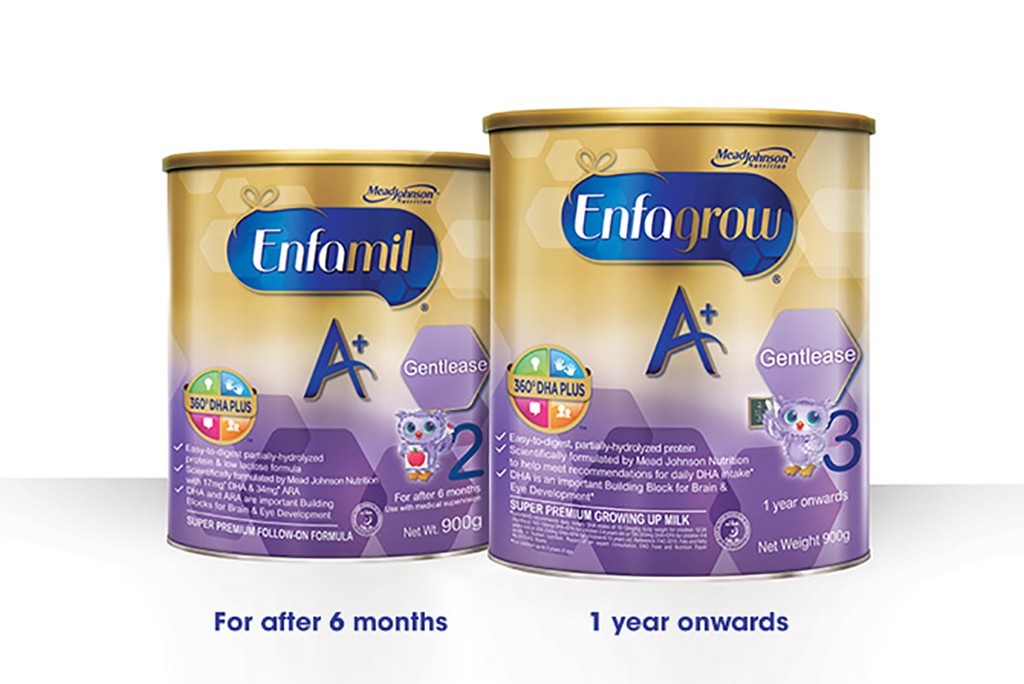SingaporeMotherhood | Baby & Toddler
April 2017
Happy Tummy, Happy Baby – What’s Feeding Your Baby’s Growth?


Once your little one is beyond six months old, you will most likely be spending more time focusing on their nutritional needs.
After a better understanding of your baby and their delicate tummy, it is important to understand the role nutrition plays in your baby’s on-going development so you feel empowered to make sure they are getting everything they need to keep their tummy happy.
“Babies with a delicate tummy may have a higher risk of getting inadequate nutrition compared to other babies. Symptoms such as vomiting and diarrhoea may reduce the absorption of nutrients into the body and thus increase the risk of having malnutrition,” shares Ms Law Chin Chin, Senior Dietitian at The Nutrition Place.
Read on to find out more about the right nutrition for your baby’s development!
The lowdown on good nutrition
It will seem like your baby is doing something new every few days after six months, seemingly growing an inch every time you take their measurements. They might be rolling over and sitting up for short periods from seven months and readily standing with support around eight months, picking up small objects by nine months, and maybe even responding to simple questions at 10 months1 – all these cognitive developmental milestones are strongly supported by parental stimulation as well as by proper nutrition2. Nutrients provide the building blocks that make up important enzyme systems in the brain3 so mums, read on for some tips on how to ensure that your baby eats well for growth!
What’s on the menu?

Mums, your baby’s nutrient demands can be met through a combination of a suitable milk supplement and solid foods from after six months. Miss Law advises that a variety of foods from different food groups should be introduced when weaning begins6.
| Food groups | Recommended number of servings per day (7-12 months) |
| Brown rice and wholemeal bread | 1-2 servings |
| Fruit | ½ serving |
| Vegetables | ½ serving |
| Meat and others | ½ serving |
| Milk | 750 ml |
Reference: Health Promotion Board, Singapore
To help you understand suitable portions, 1 serving is equivalent to the following6:
- Brown rice and wholemeal bread: 2 slices of bread, ½ bowl of rice (100 g), ½ bowl of noodles (100 g)
- Fruit: 1 small apple, orange, pear or mango (130 g), 1 wedge of pineapple, papaya or watermelon (130 g), 1 medium banana
- Vegetables: ¾ mug cooked leafy/non-leafy vegetable (100 g)
- Meat and others: 90 g of fish, lean meat or skinless poultry (90 g), 2 small blocks of soft beancurd (170 g), ¾ cup cooked pulses (e.g. lentils, peas and beans; 120 g)
Feeding your fussy baby
If your baby appears uncomfortable and unhappy during or after feeding and spits up excessively, they might be experiencing signs of a delicate tummy, says Professor Geoff Cleghorn, Director, Mead Johnson Paediatric Nutrition Institute (Asia). Your baby will not always have a delicate tummy; their digestive system will need time to develop and become fully functional.
“If your baby has a delicate tummy, wait a few days between introducing new foods to your baby to make sure that there are no allergic reactions to the new items you are introducing into their diet. Always start with small amounts to ensure that their tiny tummies are able to tolerate the food well,” Ms Law advises.
Mums, do not fret over this! All is good as long as your baby is receiving adequate essential nutrients, eating well and following the curve of the growth chart. Remember also that every baby is different and some little ones may have a smaller appetite for milk and food. They will give you all the usual signs if they are satisfied or still hungry.
Below are some of the signs showing that your baby is growing well6:
- Gaining weight gradually and following the curve of the growth chart
- Generally happy and playful
- 6-8 wet diapers daily
- Able to achieve the milestones of development
What do the right nutrients contribute to?
After six months, your baby goes through rapid development and they require a high nutrient intake to support this growth4. Research has shown that fatty acids such as DHA and ARA not only help the development of the visual system in babies, but also speed up transmission in the neurons, making for a faster brain5. DHA also makes up about 25 per cent of the total fat found in the brain and is not produced by the body in significant amounts5.
Find out more about Enfamil A+ Gentlease Stage 2 and how it will support your baby’s nutrient needs below.
What is Enfamil A+ Gentlease Stage 2 and how will it support my baby:
With over 100 years of experience in pediatric nutrition, Mead Johnson Nutrition has scientifically formulated Enfamil A+ Gentlease Stage 2 with 360° DHA PLUS for children after six months of age, formulated with easy-to-digest partially hydrolysed protein and low lactose, so it’s gentler on your baby’s delicate tummy. This formula provides balanced nutrition for supporting growth and development. Scientifically formulated with 17 mg DHA and 34 mg ARA per 100 kcal, it helps meet recommendations◆ for infants 6-12 months.

Also available: Enfagrow A+ Gentlease Stage 3 for children one year onwards.
To learn more about supporting your child’s and his delicate tummy’s development, please click here.
◆ FAO/WHO recommends daily dietary DHA intake of 10-12mg/kg body weight for infants 6-12 months. Reference: FAO 2010. Fats and fatty acids in human nutrition. Report of an expert consultation. FAO Food and Nutrition Paper No.91.FAO: Rome.
Expert Resource:
Ms Law Chin Chin
Senior Consultant Dietitian
The Nutrition Place
1 Anjana Motihar Chandra. (2016). Baby Development Milestones: 7-12 Months. Retrieved from https://www.healthxchange.sg/children/baby-0-24-months/baby-development-milestones-7-12-months.2 UNICEF. Early Childhood Development: The Key to a Full and Productive Life. Retrieved from https://www.unicef.org/dprk/ecd.pdf
3 Ngala. Nutrition and Brain Development 6-12 Months. Retrieved from http://www.ngala.com.au/files/files/861_PRG_84_Nutrition_and_Brain_Development_6-12_months.pdf
4 J. Hardwick and A. Sidnell. (2014). Infant nutrition – diet between 6 and 24 months, implications for paediatric growth, overweight and obesity. Retrieved from http://onlinelibrary.wiley.com/doi/10.1111/nbu.12118/pdf
5 (2017). Baby Brain Food. Retrieved from http://www.brillbaby.com/after-birth/baby-brain-nutrition.php
6 Interview with Ms Law Chin Chin, The Nutrition Place
This is a sponsored post.
All content from this article, including images, cannot be reproduced without credits or written permission from SingaporeMotherhood.
Follow us on Facebook, Instagram, and Telegram for the latest article and promotion updates.






